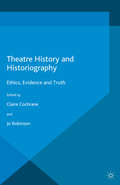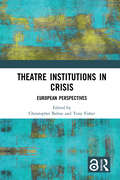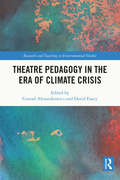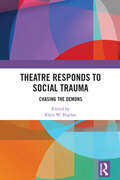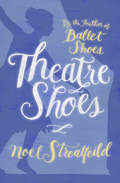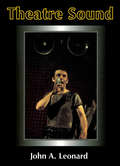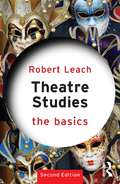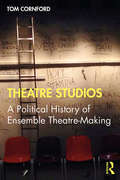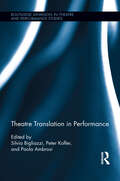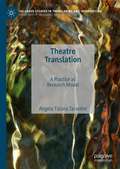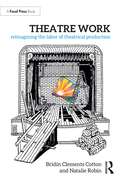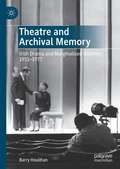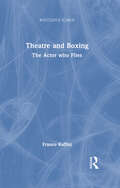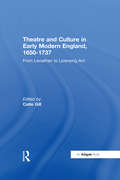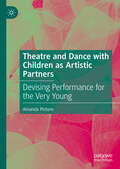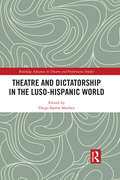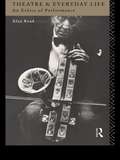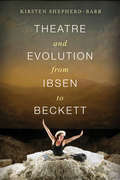- Table View
- List View
Theatre History and Historiography: Ethics, Evidence and Truth (Methuen Drama Handbooks Ser.)
by Claire CochraneThis collection of essays explores how historians of theatre apply ethical thinking to the attempt to truthfully represent their subject - whether that be the life of a well-known performer, or the little known history of colonial theatre in India - by exploring the process by which such histories are written, and the challenges they raise.
Theatre Institutions in Crisis: European Perspectives
by Christopher Balme; Tony FisherTheatre Institutions in Crisis examines how theatre in Europe is beset by a crisis on an institutional level and the pressing need for robust research into the complex configuration of factors at work that are leading to significant shifts in the way theatre is understood, organised, delivered, and received. Balme and Fisher bring together scholars from different disciplines and countries across Europe to examine what factors can be said to be most common to the institutional crisis of European theatre today. The methods employed are drawn from systems theory, social-scientific approaches, economics and statistics, theatre and performance, and other interpretative approaches (hermeneutics), and labour studies. This book will be of great interest to researchers, students, and practitioners working in the fields of performance and theatre studies. It will be particularly relevant to researchers with a particular interest in European theatre and its networks.
Theatre Masks Out Side In: Perspectives on Mask History, Design, Construction, and Performance
by Michael A. Brown Wendy J. MeadenTheatre Masks Out Side In examines masks from different angles and perspectives, combining the history, design, construction, and use of masks into one beautifully illustrated resource. Each chapter includes key information about an element of mask study: history and uses, theatre traditions, practical principles for directing, performing exercises, design considerations, mask-making techniques, and considering makeup as mask. Artist interviews, theatre company profiles, and hundreds of images provide insight into the variety of mask styles and performance applications. Project suggestions, discussion questions, useful worksheets, creative prompts, and resources for sourcing masks are included to inspire further exploration. Theatre Masks Out Side In is designed with the beginning theatre maker in mind, as well as prop makers, costume designers and technicians, and actors learning to use masks in performance.
Theatre Pedagogy in the Era of Climate Crisis (Research and Teaching in Environmental Studies)
by David Fancy Conrad AlexandrowiczThis volume explores whether theatre pedagogy can and should be transformed in response to the global climate crisis. Conrad Alexandrowicz and David Fancy present an innovative re-imagining of the ways in which the art of theatre, and the pedagogical apparatus that feeds and supports it, might contribute to global efforts in climate protest and action. Comprised of contributions from a broad range of scholars and practitioners, the volume explores whether an adherence to aesthetic values can be preserved when art is instrumentalized as protest and considers theatre as a tool to be employed by the School Strike for Climate movement. Considering perspectives from areas including performance, directing, production, design, theory and history, this book will prompt vital discussions which could transform curricular design and implementation in the light of the climate crisis. Theatre Pedagogy in the Era of Climate Crisis will be of great interest to students, scholars and practitioners of climate change and theatre and performance studies.
Theatre Responds to Social Trauma: Chasing the Demons (Routledge Series in Equity, Diversity, and Inclusion in Theatre and Performance)
by Ellen W. KaplanThis book is a collection of chapters by playwrights, directors, devisers, scholars, and educators whose praxis involves representing, theorizing, and performing social trauma.Chapters explore how psychic catastrophes and ruptures are often embedded in social systems of oppression and forged in zones of conflict within and across national borders. Through multiple lenses and diverse approaches, the authors examine the connections between collective trauma, social identity, and personal struggle. We look at the generational transmission of trauma, socially induced pathologies, and societal re-inscriptions of trauma, from mass incarceration to war-induced psychoses, from gendered violence through racist practices. Collective trauma may shape, protect, and preserve group identity, promoting a sense of cohesion and meaning, even as it shakes individuals through pain. Engaging with communities under significant stress through artistic practice offers a path towards reconstructing the meaning(s) of social trauma, making sense of the past, understanding the present, and re-visioning the future.The chapters combine theoretical and practical work, exploring the conceptual foundations and the artists’ processes as they interrogate the intersections of personal grief and communal mourning, through drama, poetry, and embodied performance.
Theatre Shoes
by Noel StreatfeildWhen their father is captured during the war, three children come to London to live with their grandmother and join their talented theatrical family in a school for stage training.
Theatre Shoes
by Noel StreatfeildThis captivating companion to Ballet Shoes tells the story of 3 orphans who become students at a famous theatre school After their father disappeared in the war, Sorrell, Holly, and Mark Forbes were sent to live with their grandfather. When he dies, the three orphans are on the move again--this time to London, where their maternal grandmother is a well-known actress. The city is a strange, bustling place that frightens young Holly, but the siblings' new home at 14 Ponsonby Square has a garden that instantly enchants them. Their grandmother enrols them at the Children's Academy of Dancing and Stage Training, where they'll carry on the tradition of their famous theatre family, which includes cousins they never knew they had. Stuck-up Miranda thinks she can act better than Sorrel; homesick Mark discovers he can sing; and Holly is a natural dancer. Will Sorrel, Holly, and Mark live up to their family legacy?
Theatre Shoes (Shoes #3)
by Noel StreatfeildThis captivating companion to Ballet Shoes tells the story of 3 orphans who become students at a famous theatre school After their father disappeared in the war, Sorrell, Holly, and Mark Forbes were sent to live with their grandfather. When he dies, the three orphans are on the move again—this time to London, where their maternal grandmother is a well-known actress. The city is a strange, bustling place that frightens young Holly, but the siblings&’ new home at 14 Ponsonby Square has a garden that instantly enchants them. Their grandmother enrols them at the Children&’s Academy of Dancing and Stage Training, where they&’ll carry on the tradition of their famous theatre family, which includes cousins they never knew they had. Stuck-up Miranda thinks she can act better than Sorrel; homesick Mark discovers he can sing; and Holly is a natural dancer. Will Sorrel, Holly, and Mark live up to their family legacy?
Theatre Sound
by John A. LeonardTheatre Sound includes a brief history of the use of sound in the theatre, discussions of musicals, sound effects, and the recording studio, and even an introduction to the physics and math of sound design. A bibliography and online reference section make this the new essential work for students of theatre and practicing sound designers.
Theatre Studies: The Basics (The Basics)
by Robert LeachNow in a second edition, Theatre Studies: The Basics is a fully updated guide to the wonderful world of theatre. The practical and theoretical dimensions of theatre – from acting to audience – are woven together throughout to provide an integrated introduction to the study of drama, theatre and performance. Topics covered include: dramatic genres, from tragedy to political documentary theories of performance the history of the theatre in the West acting, directing and scenography With a glossary, chapter summaries and suggestions for further reading throughout, Theatre Studies: the Basics remains the ideal starting point for anyone new to the subject.
Theatre Studios: A Political History of Ensemble Theatre-Making
by Tom CornfordTheatre Studios explores the history of the studio model in England, first established by Konstantin Stanislavsky, Jacques Copeau and others in the early twentieth century, and later developed in the UK primarily by Michel Saint-Denis, George Devine, Michael Chekhov and Joan Littlewood, whose studios are the focus of this study. Cornford offers in-depth accounts of the radical, collective work of these leading theatre companies of the mid-twentieth century, considering the models of ensemble theatre-making that they developed and their remnants in the newly publicly-funded UK theatre establishment of the 1960s. In the process, this book develops an approach to understanding the politics of artistic practices rooted in the work of John Dewey, Antonio Gramsci and the standpoint feminists. It concludes by considering the legacy of the studio movement for twenty-first-century theatre, partly by tracking its echoes in the work of Secret Theatre at the Lyric, Hammersmith (2013–2015). Students and makers of theatre alike will find in this book a provocative and illuminating analysis of the politics of performance-making and a history of the theatre as a site for developing counterhegemonic, radically democratic, anti-individualist forms of cultural production.
Theatre Translation in Performance (Routledge Advances in Theatre & Performance Studies #29)
by Silvia Bigliazzi Peter Kofler Paola AmbrosiThis volume focuses on the highly debated topic of theatrical translation, one brought on by a renewed interest in the idea of performance and translation as a cooperative effort on the part of the translator, the director, and the actors. Exploring the role and function of the translator as co-subject of the performance, it addresses current issues concerning the role of the translator for the stage, as opposed to the one for the editorial market, within a multifarious cultural context. The current debate has shown a growing tendency to downplay and challenge the notion of translational accuracy in favor of a recreational and post-dramatic attitude, underlying the role of the director and playwright instead. This book discusses the delicate balance between translating and directing from an intercultural, semiotic, aesthetic, and interlingual perspective, taking a critical stance on approaches that belittle translation for the theatre or equate it to an editorial practice focused on literality. Chapters emphasize the idea of dramatic translation as a particular and extremely challenging type of performance, while consistently exploring its various textual, intertextual, intertranslational, contextual, cultural, and intercultural facets. The notion of performance is applied to textual interpretation as performance, interlingual versus intersemiotic performance, and (inter)cultural performance in the adaptation of translated texts for the stage, providing a wide-ranging discussion from an international group of contributors, directors, and translators.
Theatre Translation: A Practice as Research Model (Palgrave Studies in Translating and Interpreting)
by Angela Tiziana TarantiniThis book examines the effects of translation on theatrical performance. The author adapts and applies Kershaw et al.’s Practice as Research model to an empirical investigation analysing the effects of translation on the rhythm and gesture of a playtext in performance, using the contemporary plays Convincing Ground and The Gully by Australian playwright David Mence which have been translated into Italian. The book is divided into two parts: a theoretical exegesis encompassing Translation Studies, Performance Studies and Gesture Studies, and a practical investigation comprising of a workshop where excerpts of the plays are explored by two groups of actors. The chapters are accompanied by short clips of the performance workshop hosted on SpringerLink. The book will be of interest to students and scholars in the fields of Translation Studies (and Theatre Translation more specifically), Theatre and Performance, and Gesture Studies.
Theatre Work: Reimagining the Labor of Theatrical Production
by Brídín Clements Cotton Natalie RobinTheatre Work: Reimagining the Labor of Theatrical Production investigates both the history and current realities of life and work in professional theatrical production in the United States and explores labor practices that are equitable, accessible, and sustainable.In this book, Brídín Clements Cotton and Natalie Robin investigate the question of artmaking, specifically theatrical production, as work. When the art is the work, how do employers navigate the balance between creative freedom and these equitable, accessible, and sustainable personnel processes? Do theatrical production operations value the worker? Through data analyses, worker narratives, and analogues to the evolving gig economy, Theatre Work questions everything about theatrical production work – including our shared history, ways of operating, and assumptions about how theatre is made – and considers what might happen if the American Theatre was reborn in an entirely new form.Written for members of the theatrical production workplace, leaders of theatrical institutions and productions, labor organizers, and industry union leaders, Theatre Work: Reimagining the Labor of Theatrical Production speaks to the ways that employers and workers can reimagine how we work.
Theatre and Archival Memory: Irish Drama and Marginalised Histories 1951-1977
by Barry HoulihanThis book presents new insights into the production and reception of Irish drama, its internationalisation and political influences, within a pivotal period of Irish cultural and social change. From the 1950s onwards, Irish theatre engaged audiences within new theatrical forms at venues from the Pike Theatre, the Project Arts Centre, and the Gate Theatre, as well as at Ireland’s national theatre, the Abbey. Drawing on newly released and digitised archival records, this book argues for an inclusive historiography reflective of the formative impacts upon modern Irish theatre as recorded within marginalised performance histories. This study examines these works' experimental dramaturgical impacts in terms of production, reception, and archival legacies. The book, framed by the device of ‘archival memory’, serves as a means for scholars and theatre-makers to inter-contextualise existing historiography and to challenge canon formation. It also presents a new social history of Irish theatre told from the fringes of history and reanimated through archival memory.
Theatre and Aural Attention
by George Home-CookTheatre and Aural Attention investigates what it is to attend theatre by means of listening. Focusing on four core aural phenomena in theatre - noise, designed sound, silence, and immersion - George Home-Cook concludes that theatrical listening involves paying attention to atmospheres.
Theatre and AutoBiography: Writing and Performing Lives in Theory and Practice
by Sherrill GraceThat both autobiography and biography have acquired a position of unprecedented importance over the past thirty years is now obvious. Less obvious are the reasons for this phenomenon. Theorists and students of AutoBiography, a research subject now viewed as respectable in academic circles, have recently mapped the contours and shifting parameters of the autobiographical and the biographical processes, thereby contributing to the profile and stature of both. This collection brings theatre practitioners together with academics from three continents in a groundbreaking exploration of the interdisciplinary realm of Theatre and AutoBiography. On the theoretical side, the contributors draw on a range of contemporary theorists: from Jacques Lacan, Gilles Deleuze and Emmanuel Levinas to Judith Butler, Mieke Bal and Homi Bhabha; from Elin Diamond and Jill Dolan to Leigh Gilmore, Paul John Eakin and Philippe Lejeune. In general terms, auto/biographical performances have become hugely popular forms in Europe and North America because we live in a culture of me or I at a time when access to cultural production is easy. AutoBiographies satisfy our desire for story at the same time as they promise to give us truths (if not Truth). With the post-postmodern return of the author and the waning of a deep-seated anti-humanism associated in Western culture with modernist ideology and aesthetics, a desire for agency, voice, visibility and subjectivity has resurfaced with a renewed passion--that personal identity matters and that it is not necessarily fixed by a set script we learn from birth. The playwrights discussed here could scarcely be more broadly representative of British and North American drama in the twentieth and early twenty-first centuries: from W. B. Yeats and Samuel Beckett to Michel Tremblay, Sharon Pollock and David Mamet; from Spalding Gray and Karen Finley to Linda Griffiths; and from Orlan to Sally Clark, R. H. Thomson, Monique Mojica and George Seremba, the range of styles performances and subjectivities is extraordinary.
Theatre and Boxing: The Actor who Flies (Routledge Icarus)
by Franco RuffiniTheatre and Boxing focuses on a problem which is of paramount importance for any theatre practitioner and researcher: the actor’s believable body. This problem has been taken up by Stanislavski, Meyerhold, Artaud, Brecht, Decroux, Copeau, Grotowski, and many others. It is an essential hurdle for all who practice the theatrical craft or want to study it theoretically. This hurdle can be considered one of the foundations of theatre science and of the relationship between technique, politics and ethics. This book tells the story of a revolution in the work of the actor in the early- and mid-20th century, a period in which the focus of theatrical interest shifted from the emotions to the body. The actor’s body became a tool for purveying a dynamic set of actions which often transformed the very actor himself. This new centrality of the body also drew attention to those places in which the body is central: the gym, the boxing ring and the circus with its trapezes and tightropes became, together with the stage, laboratories for the theatre. Thus, in addition to the reformers of the theatre the pages of this book are filled with boxers, acrobats, gymnasts and wrestlers, pursuers of an utopia: the "actor who flies".
Theatre and Culture in Early Modern England, 1650-1737: From Leviathan to Licensing Act
by Catie GillFramed by the publication of Leviathan and the 1713 Licensing Act, this collection provides analysis of both canonical and non-canonical texts within the scope of an eighty-year period of theatre history, allowing for definition and assessment that uncouples Restoration drama from eighteenth-century drama. Individual essays demonstrate the significant contrasts between the theatre of different decades and the context of performance, paying special attention to the literary innovation and socio-political changes that contributed to the evolution of drama. Exploring the developments in both tragedy and comedy, and in literary production, specific topics include the playwright's relationship to the monarch, women writers' connection to the audience, the changing market for plays, and the rise of the bourgeoisie. This collection also examines aspects of gender and class through the exploration of women's impact on performance and production, masculinity and libertinism, master/servant relationships, and dramatic representations of the coffee house. Accompanied by a list of Spanish-English plays and a chronology of monarch's reigns and significant changes in theatre history, From Leviathan to Licensing Act is a valuable tool for scholars of Restoration and eighteenth-century performance, providing groundwork for future research and investigation.
Theatre and Dance with Children as Artistic Partners: Devising Performance for the Very Young
by Amanda PintoreThis book offers a methodological framework for developing research-based Theatre and Dance for the Very Young (TDVY) performances in which artists collaborate with children ages 0-6 and their caregivers and/or educators as creative partners in the process. It provides a detailed investigation of all stages of the work including: designing and executing a creative research plan, analyzing tools for assessment, using research results as the foundation of a devising process, and outcomes for final performances for this age range. This process reflects on years of creative research with very young children, the results of which include methods for building collaborative performances with a variety of institutions such as early childhood centers, universities, community spaces, and non-profit arts organizations. The main themes addressed in this book are innovative methods for devising and collaboration, the translation of research into performance, and the integral bonds between early childhood development and artistic experiences.
Theatre and Dictatorship in the Luso-Hispanic World (Routledge Advances in Theatre & Performance Studies)
by Diego SánchezTheatre and Dictatorship in the Luso-Hispanic World explores the discourses that have linked theatrical performance and prevailing dictatorial regimes across Spain, Portugal and their former colonies. These are divided into three different approaches to theatre itself - as cultural practice, as performance, and as textual artifact - addressing topics including obedience, resistance, authoritarian policies, theatre business, exile, violence, memory, trauma, nationalism, and postcolonialism. This book draws together a diverse range of methodological approaches to foreground the effects and constraints of dictatorship on theatrical expression and how theatre responds to these impositions.
Theatre and Event
by Adrian KearTheatre and Event: Staging the European Century, examines how, in these first decades of the twenty-first century, contemporary European theatre-makers have sought to consider the disastrous events of the twentieth century as the 'unfinished business' of the contemporary. Kear argues that by thinking through the logic of the event, and the theatre event especially, contemporary performance practice enables an affective interrogation of 'the event' of the European century. Examining the work of leading theatre companies, Theatre and Event: Staging the European Century offers detailed expositions and engaged analyses of key works by Needcompany (Belgium), Jaunais Rigas Teatris (Latvia), Societas Raffaello Sanzio (Italy), National Theatre Wales (UK), and Studios Kabako (France/Democratic Republic of the Congo). This book offers an original conception of the theatre event as an event which exists in relation to, and performatively historicises, other 'events', requiring a critical and creative practice of spectatorship to animate its political affects. "
Theatre and Everyday Life: An Ethics of Performance
by Alan ReadAlan Read asserts that there is no split between the practice and theory of theatre, but a divide between the written and the unwritten. In this revealing book, he sets out to retrieve the theatre of spontaneity and tactics, which grows out of the experience of everyday life. It is a theatre which defines itself in terms of people and places rather than the idealised empty space of avant garde performance. Read examines the relationship between an ethics of performance, a politics of place and a poetics of the urban environment. His book is a persuasive demand for a critical theory of theatre which is as mentally supple as theatre is physically versatile.
Theatre and Evolution from Ibsen to Beckett
by Kirsten Shepherd-BarrReveals the deep, transformative entanglement among science, art, and culture in modern times
Theatre and Evolution from Ibsen to Beckett
by Kirsten Shepherd-BarrEvolutionary theory made its stage debut as early as the 1840s, reflecting a scientific advancement that was fast changing the world. Tracing this development in dozens of mainstream European and American plays, as well as in circus, vaudeville, pantomime, and "missing link" performances, Theatre and Evolution from Ibsen to Beckett reveals the deep, transformative entanglement among science, art, and culture in modern times.The stage proved to be no mere handmaiden to evolutionary science, though, often resisting and altering the ideas at its core. Many dramatists cast suspicion on the arguments of evolutionary theory and rejected its claims, even as they entertained its thrilling possibilities. Engaging directly with the relation of science and culture, this book considers the influence of not only Darwin but also Lamarck, Chambers, Spencer, Wallace, Haeckel, de Vries, and other evolutionists on 150 years of theater. It shares significant new insights into the work of Ibsen, Shaw, Wilder, and Beckett, and writes female playwrights, such as Susan Glaspell and Elizabeth Baker, into the theatrical record, unpacking their dramatic explorations of biological determinism, gender essentialism, the maternal instinct, and the "cult of motherhood."It is likely that more people encountered evolution at the theater than through any other art form in the late nineteenth and early twentieth centuries. Considering the liveliness and immediacy of the theater and its reliance on a diverse community of spectators and the power that entails, this book is a key text for grasping the extent of the public's adaptation to the new theory and the legacy of its representation on the perceived legitimacy (or illegitimacy) of scientific work.
